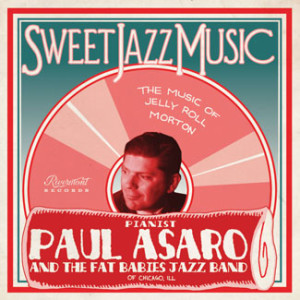Paul Asaro’s ebullient stride-piano technique vividly
evokes an earlier era. You don’t encounter pre-bebop jazz
of this quality and commitment very often anymore.”
– Howard Reich of Chicago Tribune
Browsing Tags stride piano pioneers
About Stride Piano
 Harlem Stride Piano developed out of the ragtime piano styles of New York City and the east coast, also known as “Eastern Ragtime”. The style continued the ragtime tradition of a march-like left hand see-sawing between a single bass note at the bottom of the keyboard, and a chord struck in the center of the keyboard. In general, ragtime pianists only stretched an octave or an octave and a half between the bass note and the chord in the middle but the stride pianists stretched much further towards the bottom end of the keyboard and the wider span give a much fuller sound. The syncopated figures in the right hand evolved into more varied and complicated patterns involving all manner of thirds, sixths, tenths, chromatic runs, broken chords, glissandos, and tremolo octaves. As it developed during the declining years of ragtime’s popularity and during the rise of the jazz age it further distinguished itself from ragtime piano in its sense of “swing” in the rhythm and its increasing use and the complexity of improvisation during perfomance. Stride piano was an east coast development and differed stylistically from the New Orleans jazz pianists such as Jelly Roll Morton in its voicings and melodic figures.
Harlem Stride Piano developed out of the ragtime piano styles of New York City and the east coast, also known as “Eastern Ragtime”. The style continued the ragtime tradition of a march-like left hand see-sawing between a single bass note at the bottom of the keyboard, and a chord struck in the center of the keyboard. In general, ragtime pianists only stretched an octave or an octave and a half between the bass note and the chord in the middle but the stride pianists stretched much further towards the bottom end of the keyboard and the wider span give a much fuller sound. The syncopated figures in the right hand evolved into more varied and complicated patterns involving all manner of thirds, sixths, tenths, chromatic runs, broken chords, glissandos, and tremolo octaves. As it developed during the declining years of ragtime’s popularity and during the rise of the jazz age it further distinguished itself from ragtime piano in its sense of “swing” in the rhythm and its increasing use and the complexity of improvisation during perfomance. Stride piano was an east coast development and differed stylistically from the New Orleans jazz pianists such as Jelly Roll Morton in its voicings and melodic figures.


